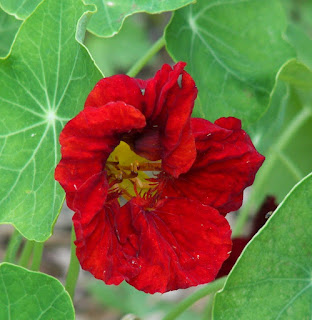Are we having a break from summer? Is this Indian summer? Did we move into fall in the blink of a week? Is this the ramification of El Nino or La Nina? Should we just relax and enjoy the perfect days, cool nights and go with the flow?
I’ve been stumped by what appears to be an early fall until I remembered we had an early spring. I fret because things are looking bad until I realize some of it is simply the pattern of nature.
Granted the drought has a major impact on how our yards are behaving. It’s hard to tell when those scorched and dried leaves from my hosta plants have moved into the dried leaves of a normal fall pattern.
In typical years, this is about the time hosta, daylilies, and many other summer flowering perennials can use a gentle haircut. It makes them neat and pushes them into a late summer burst of new leaves. It is done to make the garden beds look good. This year, I’m less eager to deprive any plant of its ability to take on energy from the sun.
Where most years trimming out dead or damaged hosta leaves is a small task, this year it would remove almost the entire foliage. Trimming daylily plants down to about eight inches typically brings on a flush of fall leaves, this year it will not make the plant look better because so much of it has already turned brown and is laying flat on the soil.
If you do fall garden clean up:
· Error on the light side.
· Remove vegetable garden waste to keep weeds and disease at a minimum.
· Cut down spent flower stalks if they don’t contain wintering bird seed heads.
· Shape up the bushes you normally keep trimmed.
· Remove weeds.
The cautionary process:
· Don’t yank out any more dead/flat/brown daylily leaves. Leave them to shelter the roots this winter. The flip side is rodents are as starved for water as your plants and may take to nesting/eating under garden mulch.
· It’s a good assumption most perennials are going into winter stressed. Anything you can do to temper roots from winter cold/wind might help.
· Mulch perennials, trees and shrubs up to 4 inches; keep away from the trunk.
· Leave the lawn grass longer over winter than normal.
· Water weekly until the ground freezes hard as long as you have the time, money and water available.
· Make wind breaks for shrubs and small decorative trees that normally have winter kill. This would be Japanese Maples, holly, and some evergreens. Basically, winter wind sucks the moisture out of these plants. Not a good year for that to happen.
Some observations:
· It appears many insecticides and herbicides didn’t work in the drought conditions. The drought may reduce the number of insects overwintering in the ground; we can only hope.
· You’ve probably noticed what many consider weeds are doing just fine with the drought. Think of the blue flowers along the roadsides (comfrey) and the white Queen Anne’s lace.
There’s a point where every gardener experiencing drought conditions must resign themselves to accepting what has been thrown at us, do the best you can and move on to next year with the gardener’s eternal hope: next year will be better.

.JPG)
.JPG)


No comments:
Post a Comment